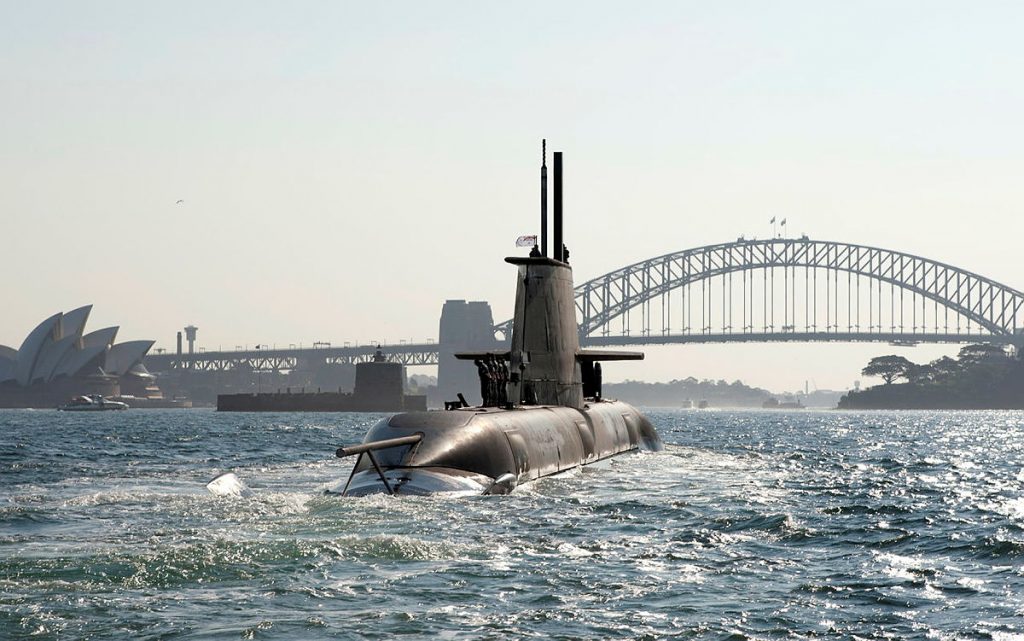 Print This Post
Print This Post- The Strategist - https://www.aspistrategist.org.au -
ASPI’s decades: Building submarines and warships
Posted By Graeme Dobell on July 12, 2021 @ 06:00

No major defence procurement project in Australian history has generated such an extraordinary saga of strategic, commercial and bureaucratic rivalries, technical snags, cultural misunderstandings, political interference and genuine national achievement as the building of the Collins Class vessels.
The project risks arising from the ‘stop start’ approach to building submarine classes could be mitigated by a rolling production model of continuous building. That would require a fleet of probably twelve boats to sustain, but the unit cost of each would be brought down and industry sustainment would be much more manageable. This approach would require a sustained government funding commitment beyond the usual forward estimate period.
Some common themes emerged: the challenge of delivering the Defence White Paper’s planned expansion of the naval fleet, the need to manage the workflow for industry to avoid a ‘boom and bust’ pattern, and the need for Australian industry to be competitive in a global marketplace.
Because of its scale and time frame, it spans every aspect of defence decision-making from long-term strategic crystal ball gazing, including the possible impact of future technologies, through military strategy development and force structuring, all the way to robust politics of shipyard jobs.
Why are they so expensive? Why do we need 12 of them? Why build them here? Why not nuclear propulsion? Why a French design? Why not an American, German, Japanese or Swedish design? Aren’t submarines obsolete, to be replaced by drones? Won’t technology make the oceans transparent?
I think we’re still paying too much, both in dollar terms and in broader opportunity costs, for our defence capability. And we’re being too patient about getting it. I haven’t won many friends in defence industry with my views on local procurement versus off-the-shelf purchases, but that’s something I’m unrepentant about. What we have today is an uneasy amalgam of defence capability development and defence industry sector support, hiding behind a veneer of ‘sovereign capability’ or ‘jobs and growth’.
Ships, aircraft and vehicles that are lost in combat with their ADF operators are almost impossible to replace in a timely way given their complex nature. The lead time for getting a new ship is at least five years. For an F-35, it’s a matter of joining a global queue.
But even if a new platform was available, the bigger limiting factor to sustaining combat of this type is that replacing skilled military personnel takes years, and, in some cases, over a decade. That means we might be deploying a force that’s unable to sustain itself against losses long enough to prevail. That’s a fancy way of saying it would probably lose.
Article printed from The Strategist: https://www.aspistrategist.org.au
URL to article: https://www.aspistrategist.org.au/aspis-decades-building-submarines-and-warships/
[1] captures the nation’s attention: https://s3-ap-southeast-2.amazonaws.com/ad-aspi/import/aspi_shipbuilding.pdf?W72vhn9RhZWoKZsBb2j0Xg1SnL5uOa7Q
[2] ambitious and controversial: https://s3-ap-southeast-2.amazonaws.com/ad-aspi/import/SI_Collins.pdf?H72ax4V6Bjoc0Iitxe30NgIdwCx29nW1
[3] Keeping our heads below water: https://s3-ap-southeast-2.amazonaws.com/ad-aspi/import/Policy_analysis16.pdf?P3TVXBls3L5HMBtUhUuUivUCPnrDVZsP
[4] $36 billion (in 2009 dollars): https://s3-ap-southeast-2.amazonaws.com/ad-aspi/import/SI_48_Submarines.pdf?eP_LFL48ZkTV2rVkVXg3a7_x5gXNpf6f
[5] Naval gazing: https://s3-ap-southeast-2.amazonaws.com/ad-aspi/import/SR31_Naval_gazing.pdf?Pweln.u49uIY6eD836yQW8tjUZikHcEj
[6] Subaqueana australis: https://www.aspi.org.au/report/subaqueana-australis-future-evolution-australias-submarines
[7] Mind the gap: https://s3-ap-southeast-2.amazonaws.com/ad-aspi/import/SI57_Mind_the_gap_sub_options.pdf?lKp8rdpU_QuXdRLCGCVj7vyOgTfV1Yws
[8] lack of agreement: https://s3-ap-southeast-2.amazonaws.com/ad-aspi/import/Strategy_submarine_choice.pdf?iQ_QB1RJZnzOHnJfHr8DWZmV5xlT_hGd
[9] build its own submarines: https://www.aspi.org.au/report/why-australia-should-build-its-own-submarines
[10] Japan defence relationship: https://s3-ap-southeast-2.amazonaws.com/ad-aspi/import/SI85_Submarines_option_J.pdf?lOhZ327Y03jr8bhwBzdr6VFGdz5cBbJZ
[11] Japan versus Europe: https://www.aspi.org.au/report/japan-versus-europe-quest-build-australias-future-submarine
[12] arguments: https://www.aspistrategist.org.au/click-go-readers-strategist-top-10-2017/
[13] ‘the very hungry future submarine’: https://www.aspistrategist.org.au/the-very-hungry-future-submarine/
[14] Submarines: your questions answered: https://s3-ap-southeast-2.amazonaws.com/ad-aspi/2020-11/SR%20161%20Submarines_Your%20questions%20answered.pdf?wIOA0OmHVANberKRdkahqghNwBef796O
[15] making it up as went go along: https://www.aspistrategist.org.au/shipbuilding-making-it-up-as-we-go-along/
[16] paying too much: https://www.aspistrategist.org.au/farewell-writing-arms/
[17] edge had dissipated: https://www.aspistrategist.org.au/the-return-of-combat-losses/